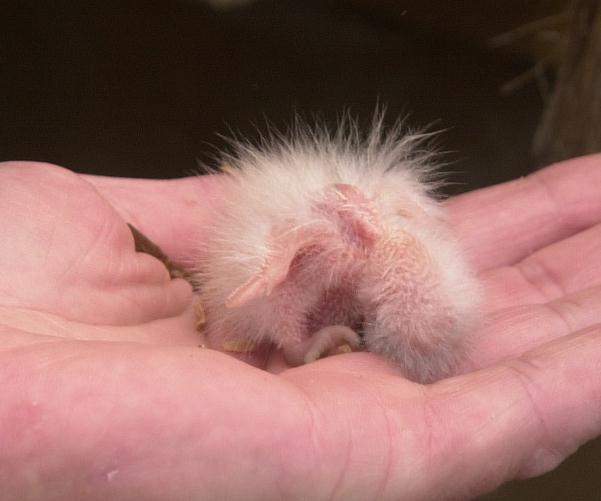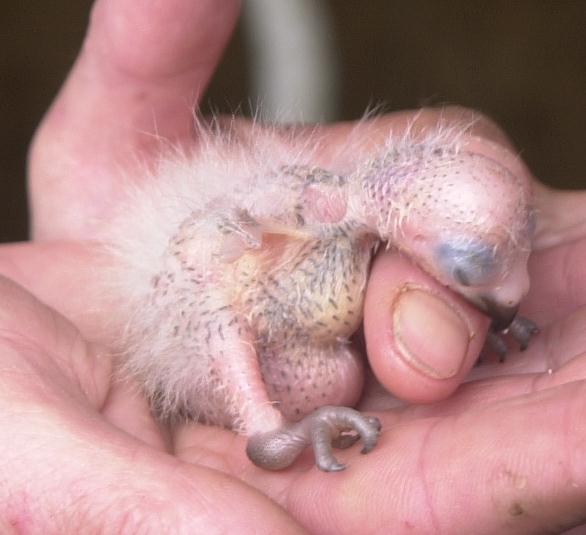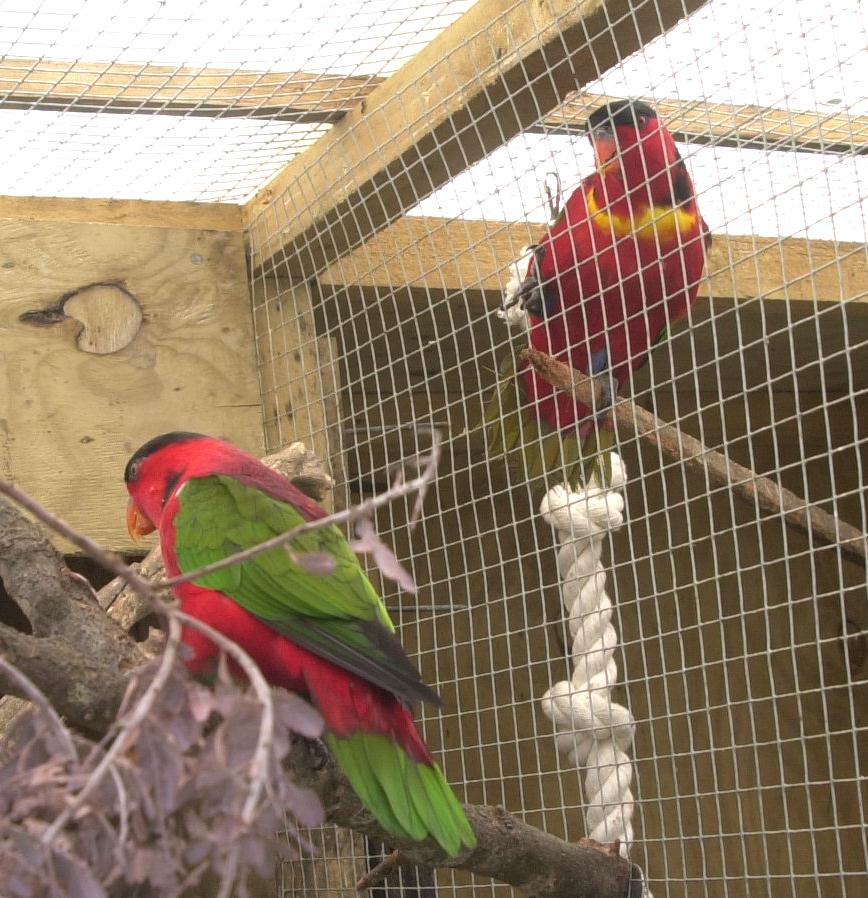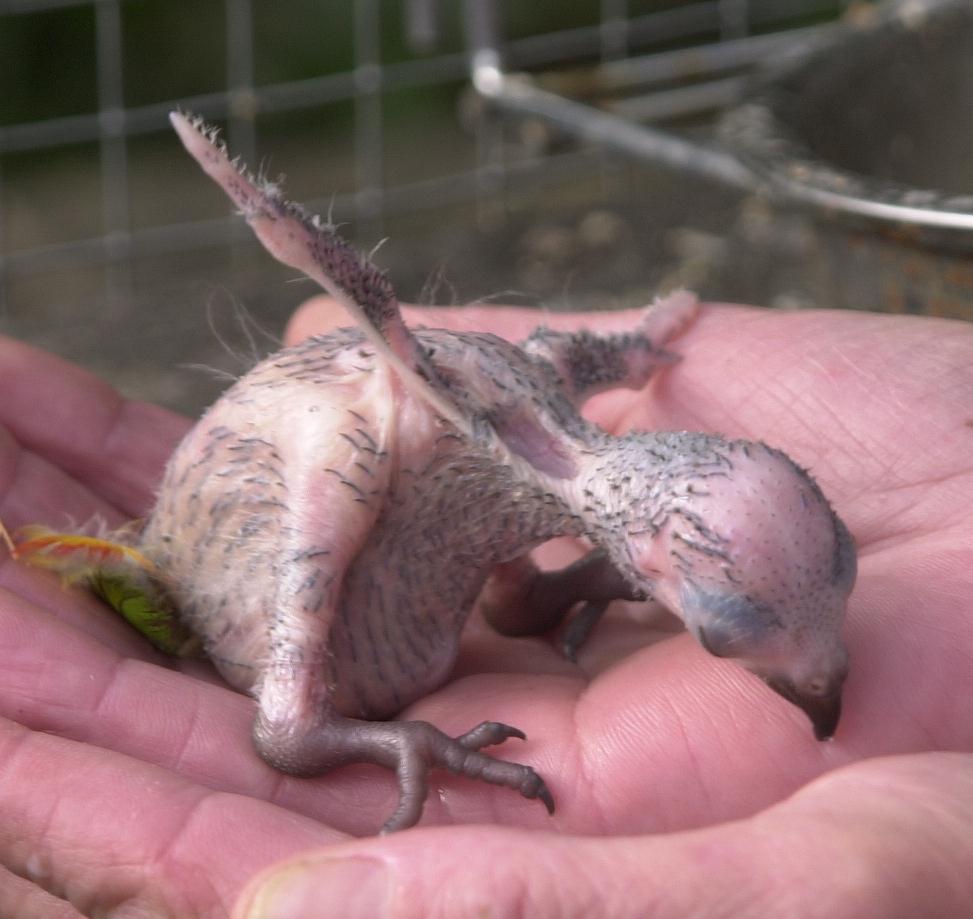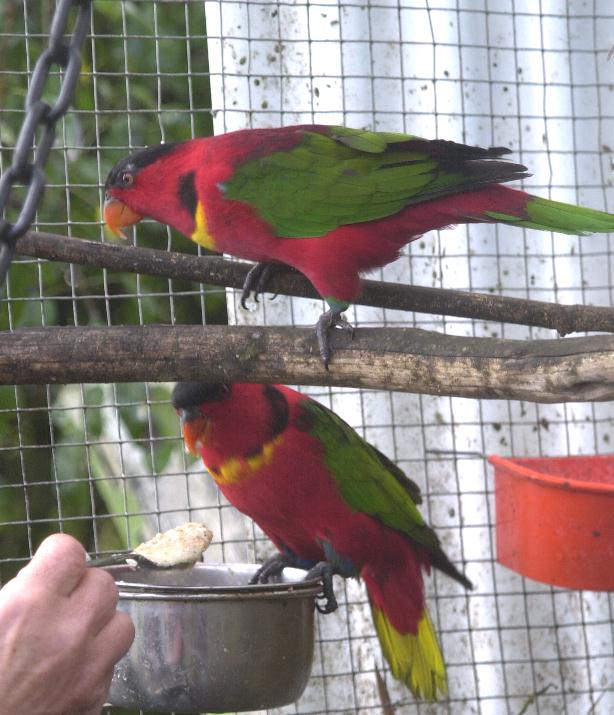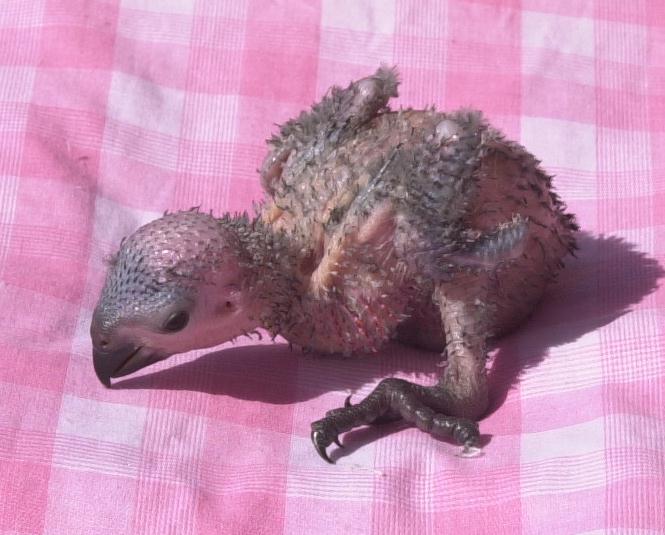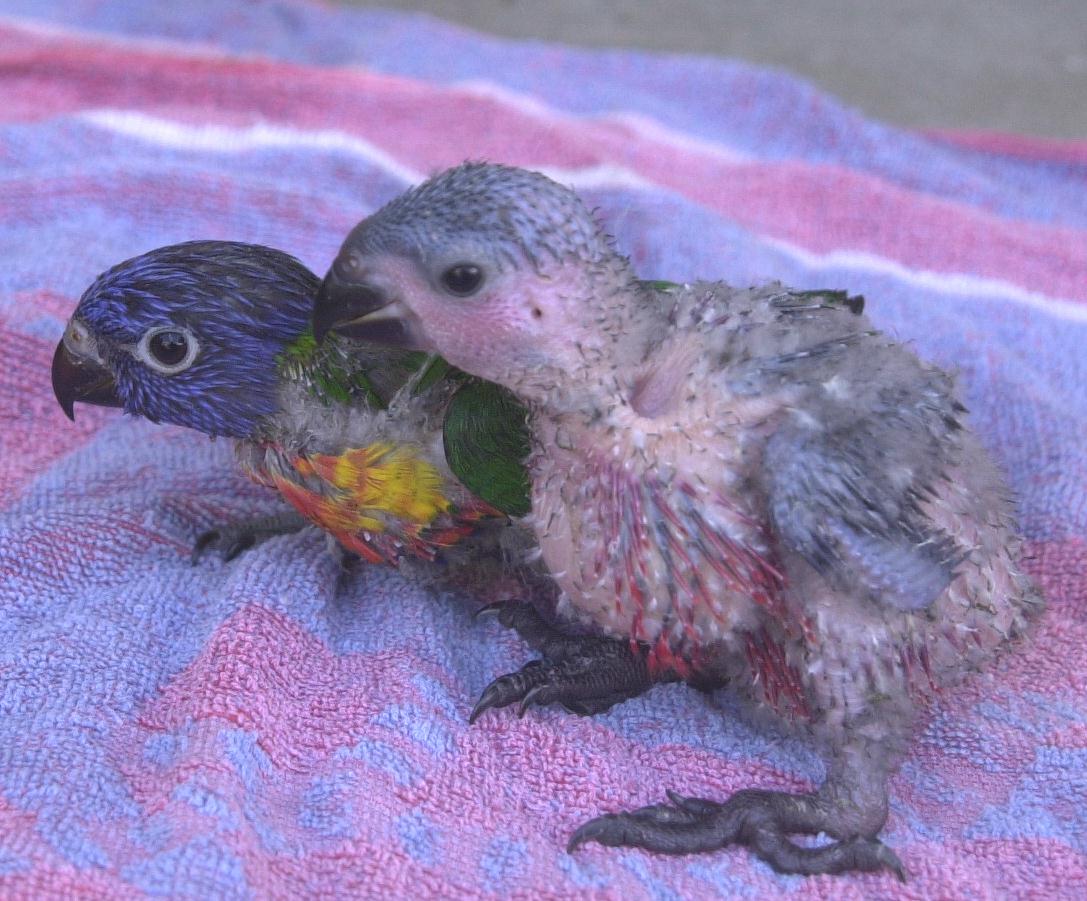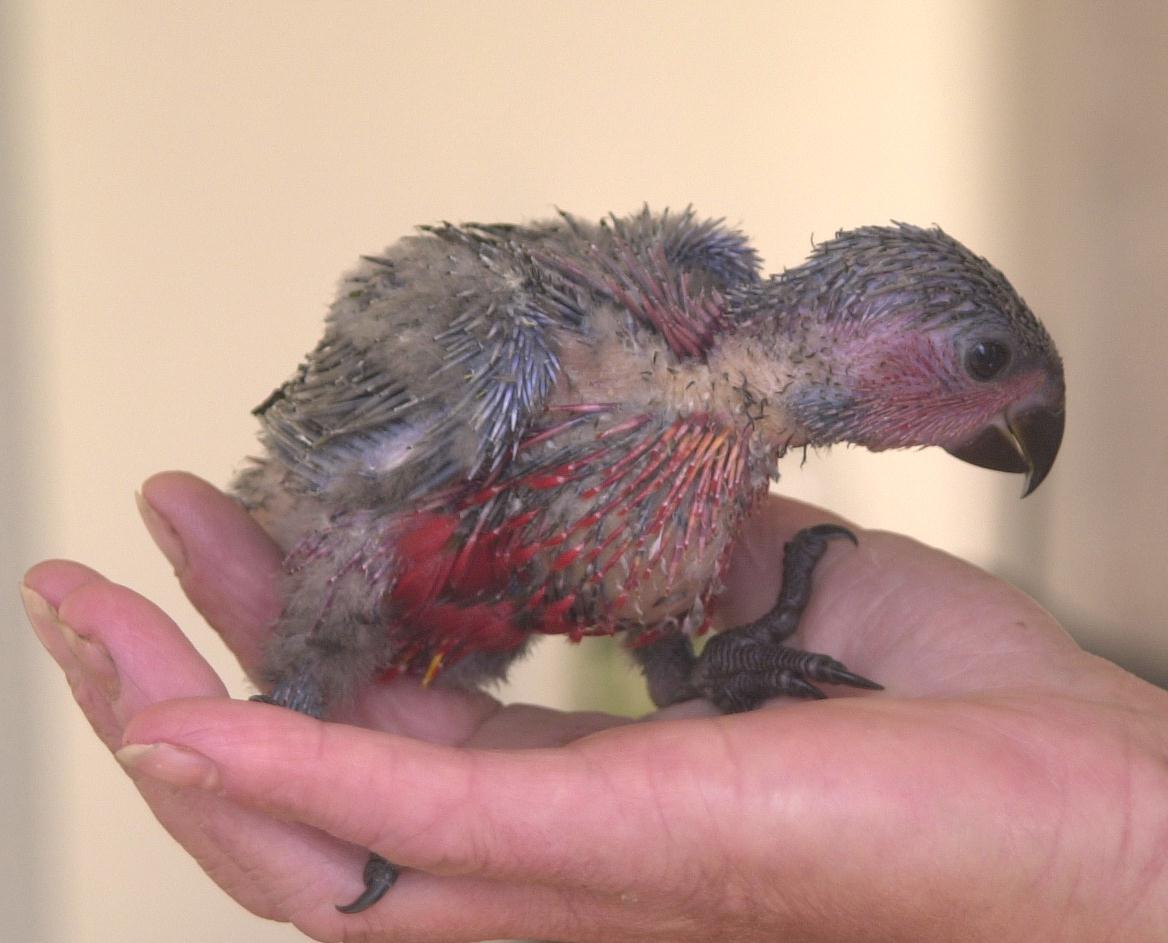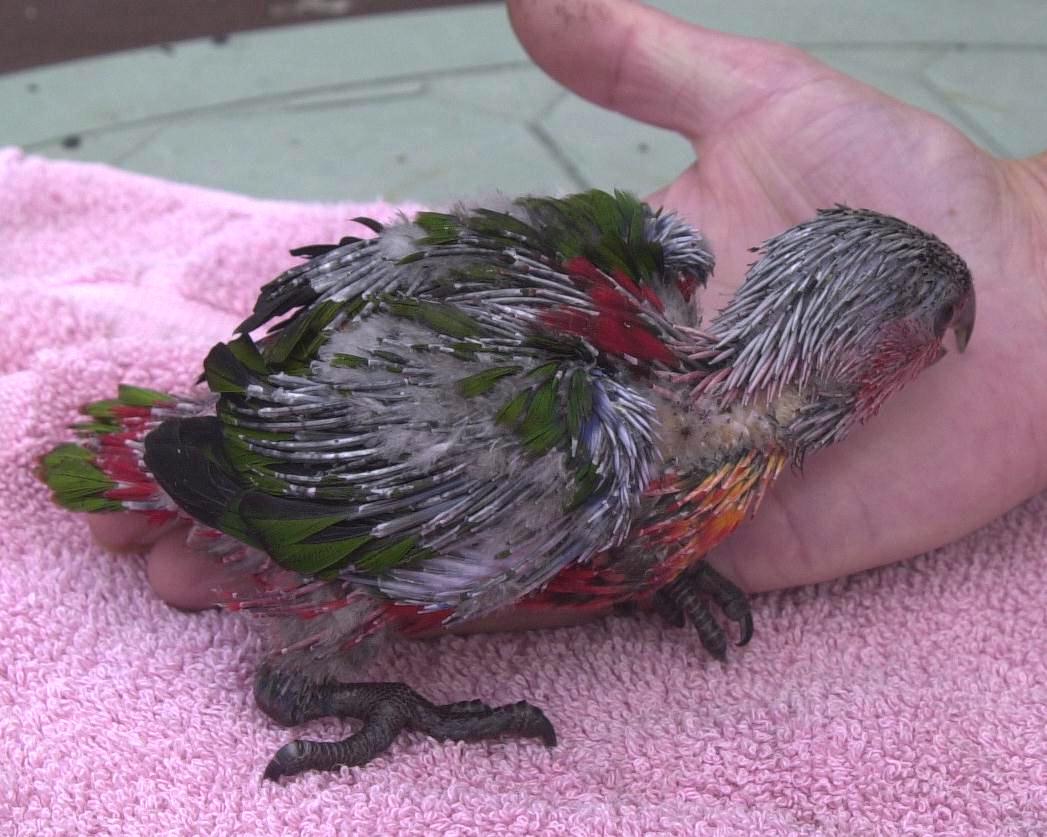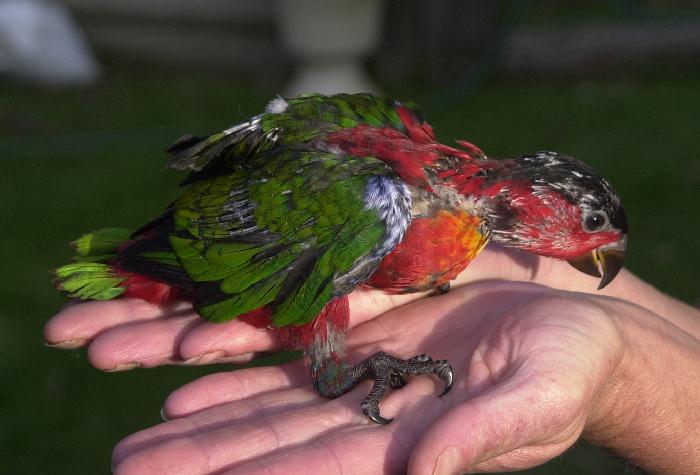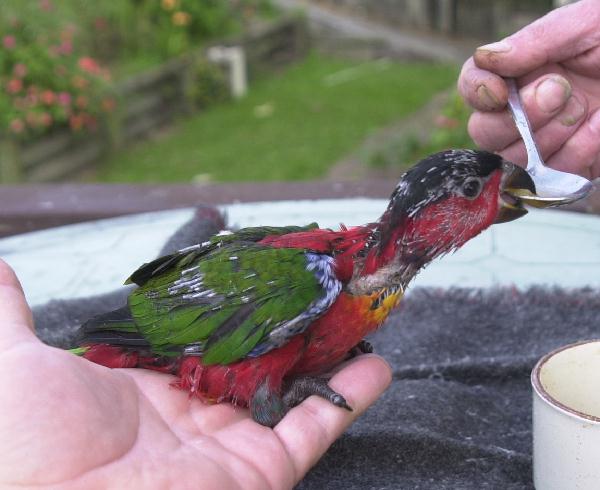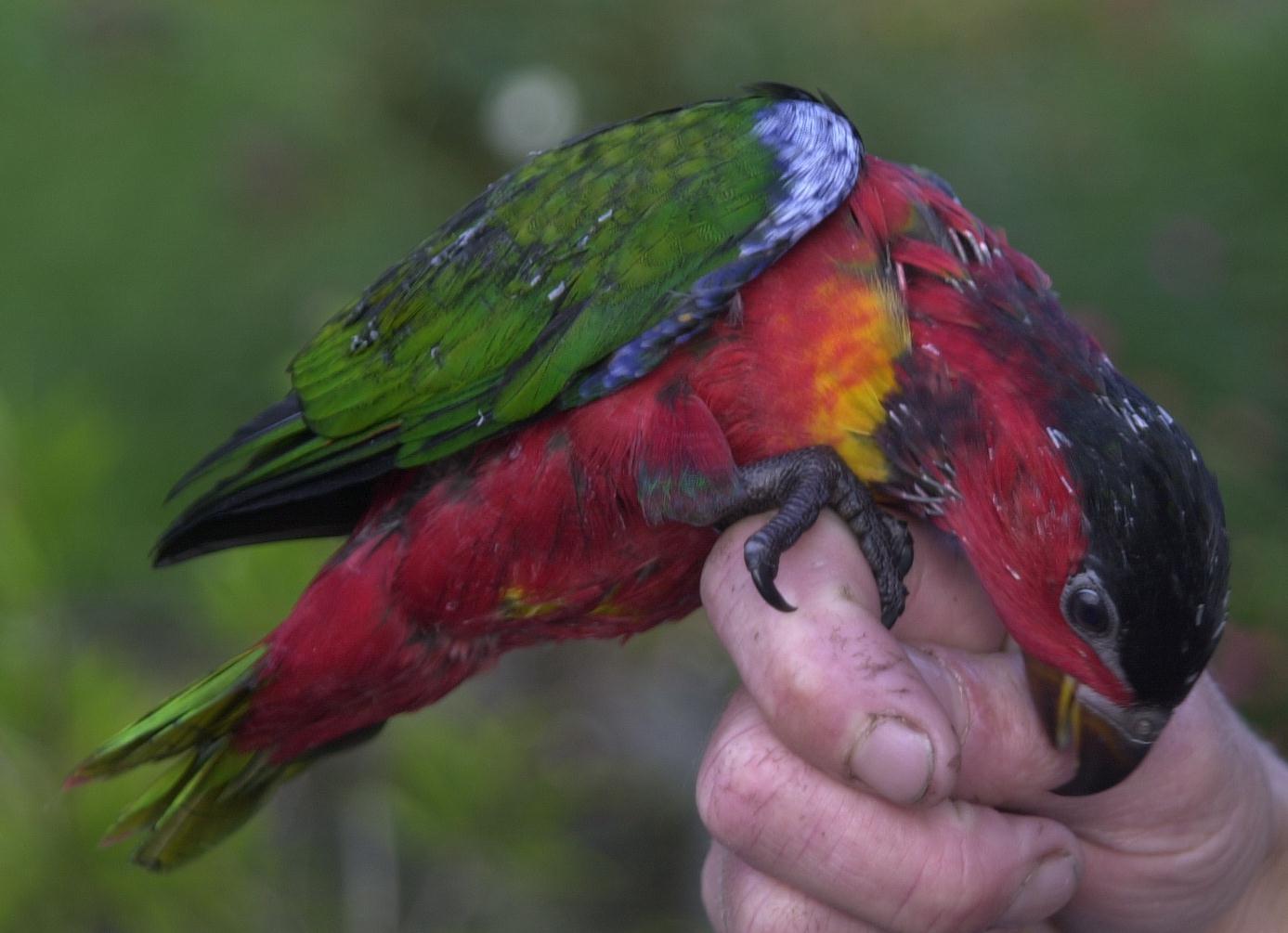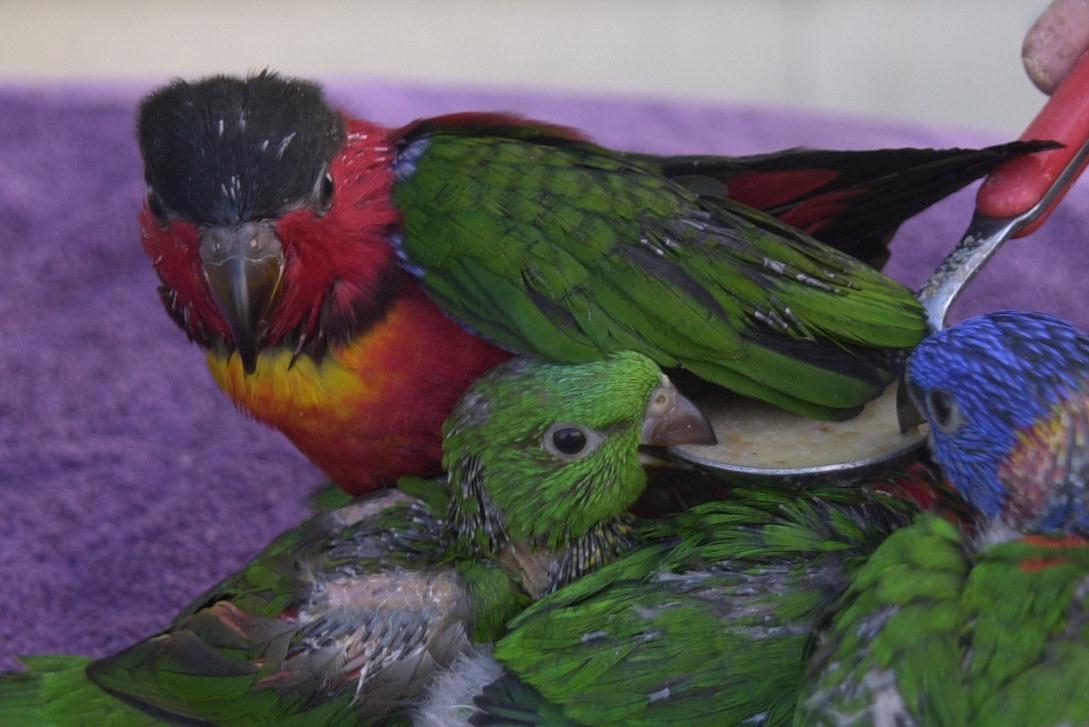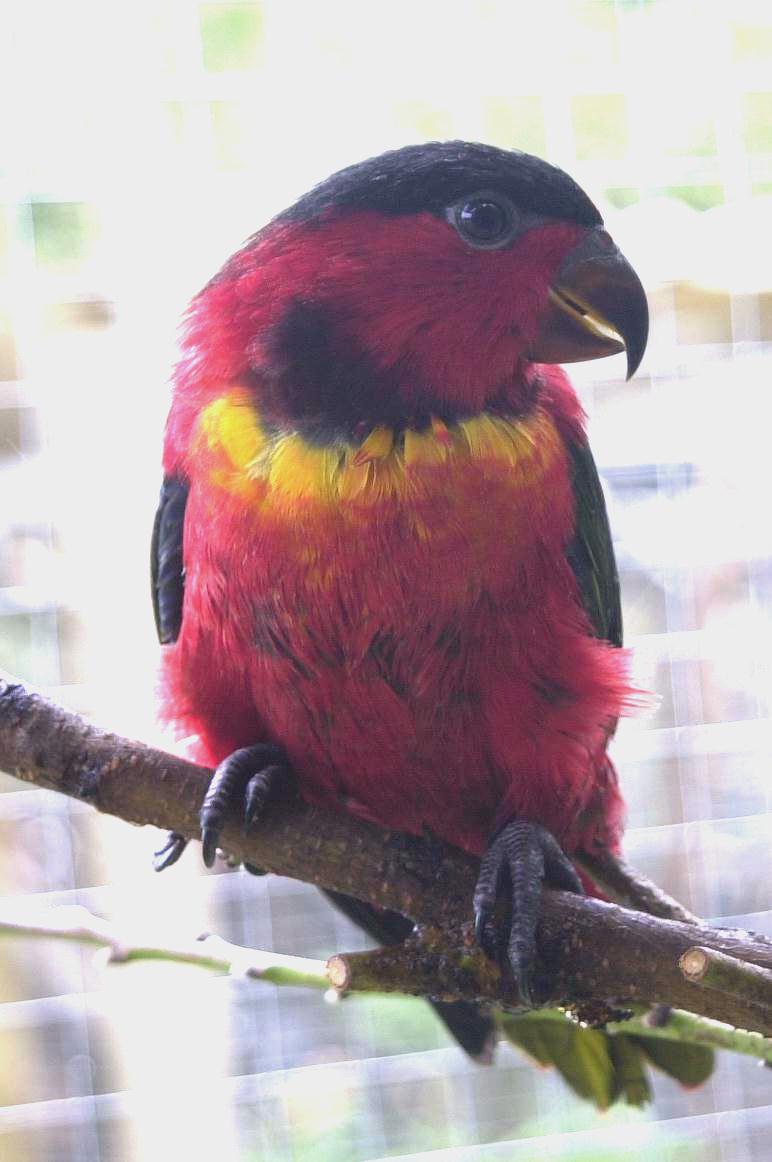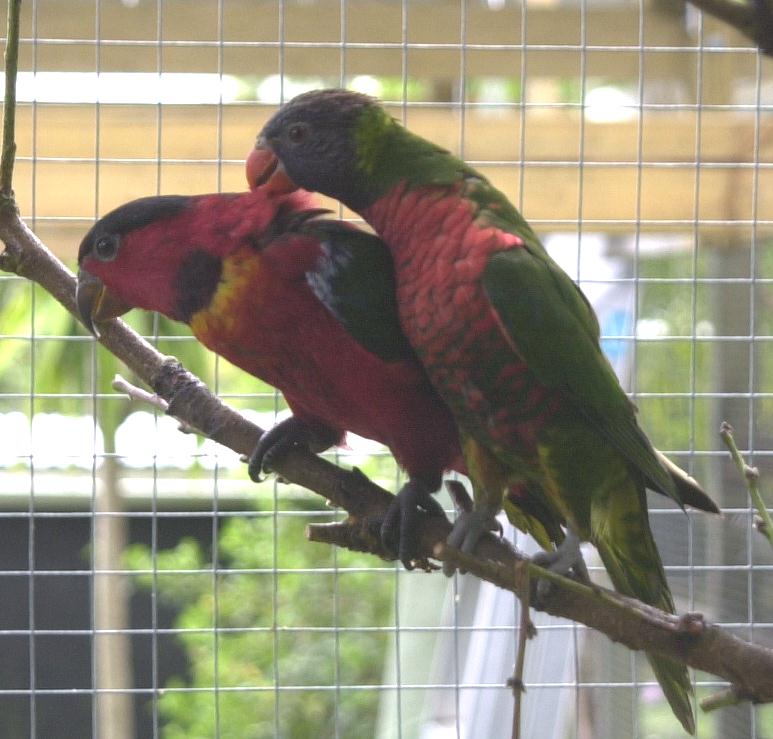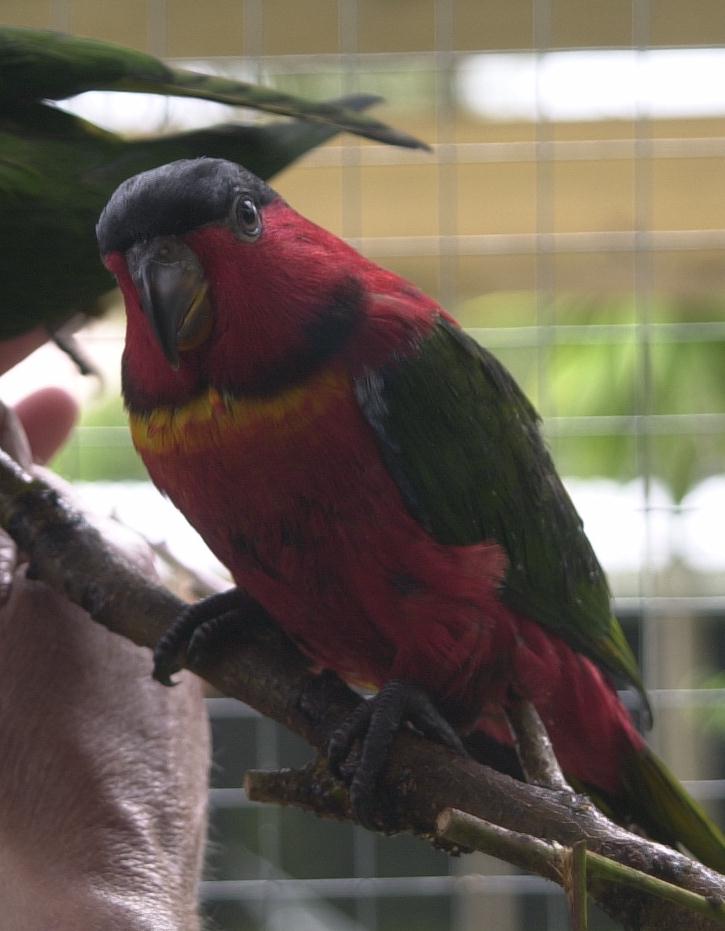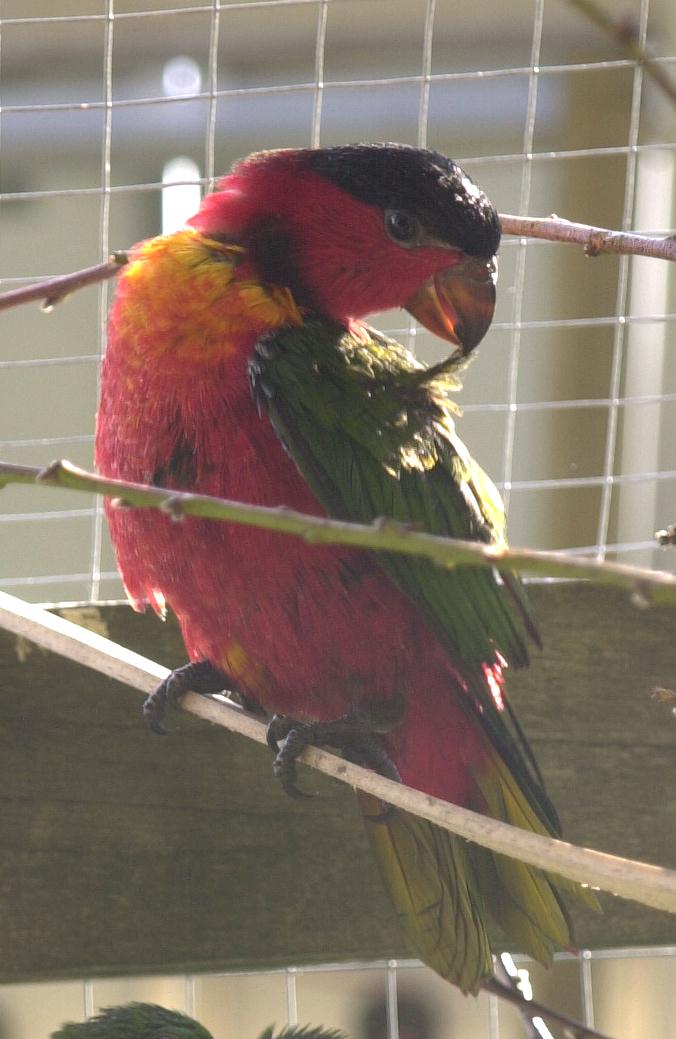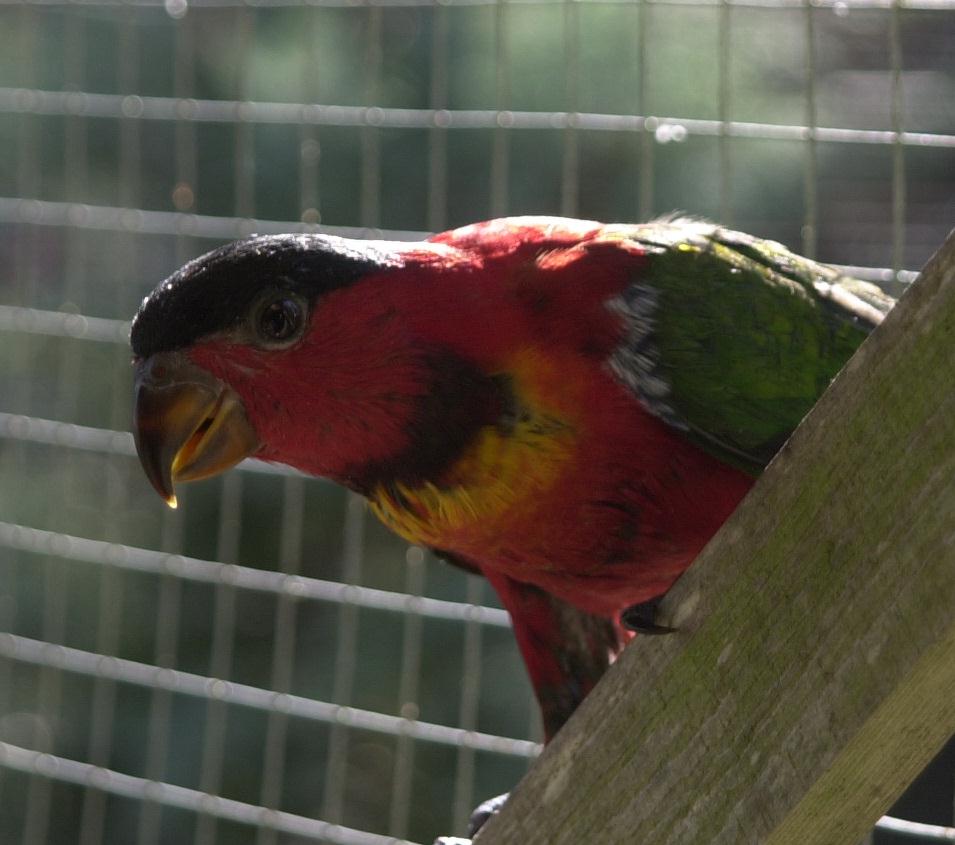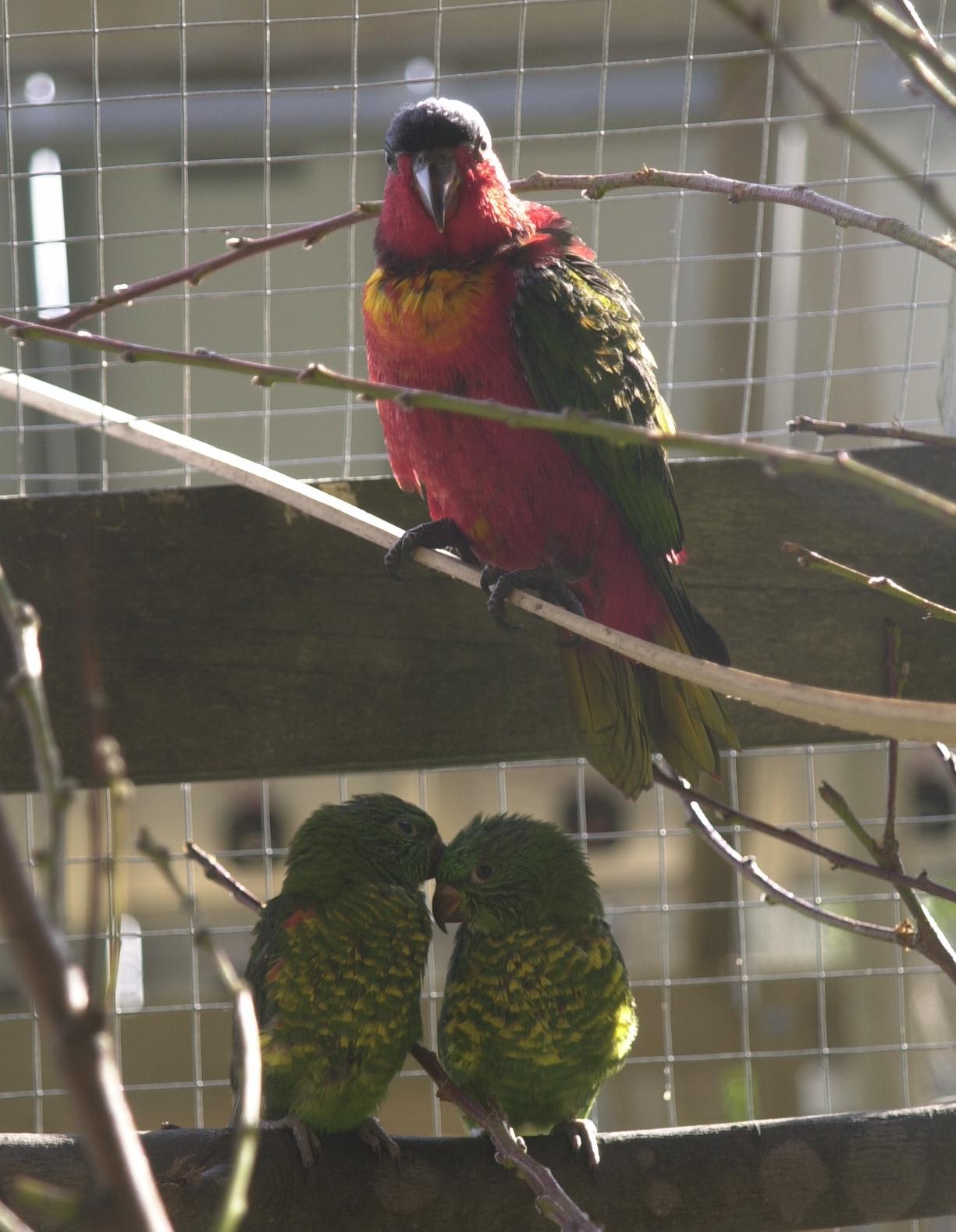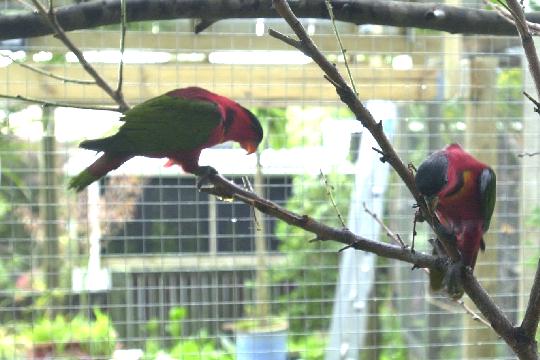Making Yellow-bibbed Lories.
by David Dix
Want a real challenge? Get a pair of Yellow-bibbed Lories to successfully
raise babies. Or just try getting fertile eggs or any eggs!
This is the story of a pair of mature breeding Yellow-bibs who had produced
about six offspring before we obtained them. They are one of three pairs
of Yellow-bibs we have and the only pair so far to produce fertile eggs.
The story is ongoing and as the latest baby yellow-bib develops further images
and updates will be added until the baby is fully fledged at about 10 weeks.
There are images of the baby taken exactly every seven days since it was
removed from the nestbox at three weeks. Before this there are images at
24hours and eight days old. The baby's growth can be guaged by comparing to
the size of the human hand in nearly all images
Almost hatchling
If there can be a problem with this pair then I think we have had it, although
we did actually
manage to raise one Yellow-bib to an adult but this was only after we lost
at least seven fertile eggs, had several infertile eggs and lost a 2 week
old chick.
One of those fertile eggs was a day away from hatching and it
was heartbreaking to find a smashed egg and just a piece of skin with down
hairs on the floor of the aviary. We could not figure out what had happened
and checked everywhere for evidence of rodents although nothing was found
(and in any case we have an excellent tom cat who can detect and dispatch
any rodent within days of it appearing). We were mystified as to what had
killed our 'almost' hatchling.
Faulty incubator
The two week old baby was doing real well in the incubator (parrot raising
module from Brinsea) when one morning it was found cold and did not recover
- apparently the Brinsea had went faulty and failed to keep the set
temperature. Losing a yellow-bib to faulty equipment was another heartbreak
considering the baby was progessing quite nicely.
Other fertile and infertile eggs just disappeared, rarely was any evidence
of the eggs found, no shell fragments and no egg contents.
What was happening here?
The vanishing eggs
The pair of Yellow-bibs responsible for all of these eggs and two babies
seemed quite nice when we obtained them at the start of August 2001. They
came complete with nestbox containing one fertile egg. That was the 'almost'
hatchling egg. Over the next six months the hen produced many more eggs wiht
most being fertile. Usually the eggs just vanished.
Our frustration continued until October, when
with another disappearance of two fertile eggs the nestbox was searched
and to our surprise an intact egg was found buried in the nesting material.
The egg was still warm so it was removed and placed under a Rainbow lorikeet
hen who had laid infertile eggs. To our great pleasure this egg successfully
hatched and the Rainbows raised the chick for nearly two weeks before they
abandoned it (we checked several times each day). It was then hand raised
and became a beautiful juvenile self sufficient Yellow-bib, sex as yet
undetermined although we initially thought a hen it could be a cock bird.
This will become clearer as the feathers just above it's legs colour up
to be more blue for a cock, or green for a hen.
Within a week of finding this egg the hen Yellow-bib laid two more eggs.
This time one was fertile so it was removed and placed under Scaly Lorikeets
on infertile eggs. Again this hatched but was removed after just a few days
when it was abandoned. It was hand raised for near two weeks until it died
from cold after the incubator failed.
It was him, the cock bird
The disappearing eggs saga had to be solved and it was becoming clearer that
the cock Yellow-bib was probably responsible. When the hen laid eggs she
would become very very protective of the nestbox and would only come out
very briefly for food. Often the cock would keep her away from the food but
then he would feed her at the nestbox entrance hole. If he made a move towards
the nestbox when the hen was out she would panic and fly back to stop him.
She became very agitated with him near the nestbox although at night he
would sleep inside the nestbox.
After two more eggs were lost in December 2001 we decided to separate the
birds the next time the hen laid. In late January 2002 she laid two eggs and
after
a few days it appeared that both were fertile. After a further three weeks,
which was about the time the eggs would usually disappear, we took the cock
away and into an ajoining aviary which had been vacated for him.
Initially he was quite upset and would continually call out for the hen, at
night he did not settle and would call intermittently throughout the night.
After a few days he eventually went into a nestbox and slept there at night.
He could still see the hen and get quite close to her during the day.
This appeared to be the secret to avoid undue stress with either bird, so long
as they can see each other and still be in relatively close proximity then
they appear to be reasonably happy. When both are inside their respective
nestboxes they can be heard making soft cooing sounds to each other.
The happy hen!
The biggest surprise came with the hen, she was a different bird and seems
to enjoy life a lot more without the cock. She will come out for food much
more often, stay out longer and appears much more relaxed knowing the cock
is still close to her but unable to sneak into the nestbox.
And the most pleasing result is that the eggs have survived so that on
Saturday 23 February at about 3pm one of the eggs hatched. Re-inspecting
the second egg we ere not sure if it was in fact fertile. It had not hatched
by 25 February so it was removed from the nestbox and did indeed prove to be
infertile.
The hen Yellow-bib is looking after the hatchling which seems in excellent
health and well stuffed with food.
Now we are hoping the hen will continue to raise the chick for at least three
to four weeks when it will removed for hand raising until fledged.
After two weeks the baby has probably tripled in size (see images below), is
well fed and seems quite healthy. The hen is quite protective of him and
after eating rushes back to the nestbox.
Separation
The idea to separate these Yellow-bibs came about after reading several
internet articles about egg breaking/egg destroying problems with some birds.
Other people's experience showed that a hen lory has no problem raising babies
on her own, so long as she has ample food and water near the nestbox and the
nestbox is safe from other birds and predators. Keeping
the adults within sight of each other and preferably quite close also
minimises any separation stress that could occur.
We were fortunate to have two 2.4metre aviaries beside each other, these
Yellow-bibs were already in one and it was quite easy to make the other
available for the cock Yellow-bib to move into. The hen just stayed in her
existing avairy and suffered no disturbance. Even though separated by aviary
wire the cock has been seen feeding the hen, this appears to be reinforcing
their bonding to each other. The hen often looks for the cock when she comes
out of the nestbox and although she may have already had food she will still
wait for the cock bird to feed her a few morsels. Both will often go into
display mode with much feather ruffling, tail shaking, bobbing up and down and
accompanied by excited whistling and cooing.
The egg hatches
Just on the expected time, 28 days after the hen starting sitting on both eggs,
the fertile egg hatched. We knew there was sommething happening as the hen
spent the whole day in the nestbox and did not venture out, even for food.
It was impossible to inspect the egg for the last few days before hatching
since it was almost impossible to get the hen away from the nestbox.
The next day we were able to inspect the new hatchling and it looked good with
it's first long wispy down keeping it warm. (see image below left).
Eight days later we again inspected the hatchling while the hen was preoccupied
with feeding. The first long white down is now being replaced with the second
darker down, this can be seen in the image below right.
24 hour old Yellow-bibbbed lory hatchling |
8 days old, growing fast |
Yellow-bib hen and cock in ajoining aviary |
Now 3 weeks old, being removed for hand raising |
Removing the baby
The new baby was inspected on a regular basis to ensure the hen was feeding him
and there were no other health problems. The nestbox was also inspected to make
sure it did not become too damp and that there were no ant or other insect
infestations.
When the baby was 21 days old it appeared that the hen had
removed almost all of his down covering as he appeared almost completely bald.
This may have been a natural change from the new hatchling's long white down to
the new grey/black down but this was not a stage we remembered with the
previous hand raised yellow-bib.
There was just a hint of new darker down starting to appear, eyes were just
getting opened and he was well fed and growing quickly.
(see image above right)
We decided to remove him from the nestbox and start hand raising.
He was placed with a five week old baby
rainbow lorikeet for company and they both soon snuggled up together. The
rainbow was just starting to feather up and the baby yellow-bib would get
tucked in below the warm feathers.
Hand raising allows us to monitor the yellow-bib's growth, provide a controlled
diet based on Kaytees, and removes any possibility of feather plucking.
Past experience with hand raising shows that placing a lone baby bird with
a similar aged baby for company seems to create a more social bird as its
gets older. Hence proving the point that the best company for a lory is
another lory!
Back together again
Now that the three week old baby has been removed the adjoining door between
the two aviaries was propped open so that the hen and cock could get together
again.
This took a couple of days as each tended to stay in their own aviary athough
each would visit into the other's aviary and would often be seen together.
For a few days they each continued to sleep in their own nestboxes.
The hen then explored the cock's nestbox and from that day she has moved into
the new nestbox and now sleeps there with the cock.
They both seem to enjoy
having access to both aviaries and will often been seen apart and playing/displaying while separated. The cock also continues to feed the hen through the
aviary wire from time to time as if this has now become some sort of
ritual feeding process.
Having their own private spaces also appears to have made both birds much
more relaxed. Before they were separated the cock would tend to dominate the
hen and occasional arguments would break out. The hen now behaves much more
confidently, perhaps successfully hatching an egg and having a baby to raise
for a few weeks has made her less fearful of the cock entering the nestbox and
destroying eggs or killing hatchlings.
Together again sharing some food |
The baby grows
23 March 2002
Four weeks old and the baby yellow-bib is growing fast. In one week he has
doubled in size, eyes are open, feet have developed, some red colouration is
appearing on his chest and he is more aware of his
surroundings. Apart from the baby 'fed-me' continual squeeking he also
makes some inquisitive soft whistles when taken out of the incubator and can
look around a room.
He can also now walk, rather wobbly, but is learning how to grasp with those
large feet and sharp toenails.
Since removing from the nestbox the diet has been KayTees hand rearing
formulae for parrots. We have tried various diets based on Dutch Mix and
human baby foods but none of these compare to Kaytees for growth and plumage
development.
(see image below left)
30 March 2002
Five weeks old and growing even faster, has increased about 50% in size in one
week, now stands upright, is better balanced and looks around, much more
alert and makes a wider range of sounds from soft whistles to the feedme
squawk.
Plumage/down is looking much better with pronounced feather pins on wings,
red/yellow plumage appearing on his chest and lower body. Much more white
down, all down seems to have become light cream/white colour.
This is quite
different to the previous baby from the same parents which at five weeks old
was almost totally covered in black down with feather pins showing through.
Feet are bigger and he is now larger than a near seven week baby rainbow
lorikeet that he has for company.
(see image below right)
4 weeks and dark down developing |
5 weeks, larger with feather pins |
6 weeks and colors evident |
7 weeks and feathering up |
..and grows
6 April 2002 (see image above left)
Six weeks old now and a much more confident bird. Feather pins growing fast
and colours appearing everywhere. The red lower underbelly is clear and the
light blue on the inner wing as well. More pins appearing on face, wings
and a tail is developing.
Note the red on side of face and black on top of head. Those large feet are
now fully functional and the baby can walk upright and almost climb up a cage.
During this last week there were a few days when all food was regurgitated
and feeding on electrolyte solution was necessary for a day before resuming
honey water and Kaytees. The feeding regime is now back to normal. One
very noticeable feature of this yellow-bib baby is that it is significantly
larger at six weeks than was the previous hand raised Yellow-bib. Maybe this
is due to the parent hen feeding this baby for three weeks before it was
removed for hand raising. There has been no difference in the two babies
diet while hand raising, they both have a Kaytees based diet.
Eggs again
8 April 2002
The hen laid two eggs after just over three weeks with the cock sharing her
aviary again. She has moved into defensive mode again and keeps the cock away
from the nestbox and eggs. The eggs will be inspected in about 8 days to
check if they are fertile.
Baby feathers
13 April 2002 (see image above right)
Seven weeks old. Still growing, body mass is now about half again than a week
ago. Feathers are appearing everywhere and the colours are much
more obvious. Tail has sprouted and flight feathers now developing, Wing
exercises now quite regular. Appearance is probably at the oddest stage as
long growing feather sheaths almost totally cover the body, they are most
noticeable on the head. Very alert and calls for food. Still living in
a plastic bucket kept above hot water tank where temperature is about
25 to 28 degrees C.
Every evening this baby now expects to be cuddled for several hours usually
while humans are watching TV. The feather sheaths are gradually broken away
during tickling and playing, exposing much more of the new feathers. This bird
is now a real pet, totally spoiled and always wants human attention.
At seven weeks this baby is much larger than our previous yellow-bib at the
same age. Once again we think this may be a cock bird as there is significant
blue feathering above the feet and on the thighs although only a dna sex
test will confirm sex.
Separation again
14 April 2002
Time to remove the cock bird again, into the ajoining aviary. He was upset
again and cried out for several hours until he settled into the nestbox for
the night. The hen appears, yet again, not to be concerned with the separation,
she does look for the cock when she ventures out of the nestbox but once she
sees and hears him she then ignores him.
One egg is fertile
18 April 2002
Inspecting the eggs today and one is darkening up whereas the other remains
quite clear. This is now proving to be a pattern with this pair of Yellow-bibs
as each of the last six pairs of eggs has had just one fertile egg.
Almost a real bird
20 April 2002
Eight weeks old and now getting near completely covered in feathers, looking
like a real Yellow-bib even though the plumage is still somewhat scruffy in
appearance. Tail and wing flight feathers now coming out fast.
Lots of attention every night being tickled and scratched to help the feathers
break out of their sheaths.
Much more independant and moved into a large cage a few days ago, has just
learned to self-feed from a food bowl in the cage although still enjoys being
hand fed from a spoon.
(see two images below)
8 weeks and now a Yellow-bib, note full crop |
Still enjoys hand feeding, note empty crop |
9 weeks plumage nearly complete |
Now has friends, scalies and red-collars |
almost an adult..
27 April 2002 (see images above)
The baby yellow-bib is now just about fully feathered with only a few feather
pins still to fully grow.
During this last week he/she was moved into a large
cage along with two seven week green scalies and two six week red-collars.
The yellow bib has become friends with one of the scalies and they all appear
to enjoy being together with much cuddling and cooing between them.
eggs vanish...
29 April 2002
This morning we found the hen was in the ajoining avaiary with the cock bird
and the two eggs (one fertile) had disappeared, not a trace of shell or
contents. And just a few days away from the fertile egg being due to hatch.
What a disaster! We cannot figure out what has happened as earlier this morning the hen was secure in her own aviary and then by midday she was found in the
cock's aviary. It now seems most likely that the cock has somehow got into
the hen's aviary, scared her out of the nestbox then proceeded to devour the
two eggs. Since not a trace of either egg has been found this is difficult
to accept.
The only other explanation is that there was some human intervention and the
eggs have been removed. Maybe its time to review avaiary security!
The End
30 April 2002
Now is probably the time to finish this story, we end just as confused as we
were at the start with yet another egg disappearance. In between we did manage
to raise one Yellow-bib, its development each week described above. It is now
just about to fledge and will in the next 10 days or so be moved to an outside
aviary and be in the company of several similar aged birds.
Hand raising a yellow-bib from just over three weeks old has been a most
enjoyable experience, the bird is probably now fully convinced it is a human
as it always wants human company. Placing it with the two red-collar and two
scaly chicks has been a good move as it just loves the company of other
birds to snuggle into when playing and sleeping.
10weeks and first time in aviary |
4month Massena wants to be boss |
looking more cute on second visit |
12weeks and now aviary boss |
beak has lost some black, orange showing |
with two scalies she grew up with |
With older sibling |
The end again
12 May 2002
The images above show the new yellow-bib from 10 weeks old to just over 12 weeks
old. She was shy when first introduced to a communal aviary which already had
several residents - a 6 month old Massena, a 4 month rainbow and three adult
scalies. At the same time two more baby scalies were introduced, these were 9
weeks old and had been hand raised with the yellow-bib.
The massena is a male and very bossy, he has tried to let the yellow-bib know
he was in charge but this situation changed quite quickly once the yellow-bib
became more confident. Now he appears to be number two and recognises the
large body and especially beak the yellow-bib posesses..
The last image shows the new yellow-bid with an older seven month old
yellow-bib, from the same parents.
See article about IZZY the yellow-bib
